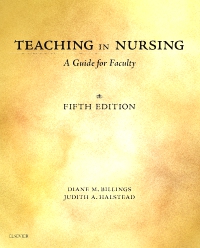
Teaching in Nursing - Elsevier eBook on VitalSource, 5th Edition
Elsevier eBook on VitalSource

Now $75.95
Set yourself up for success as a nurse educator with the award-winning Teaching in Nursing: A Guide for Faculty, 5th Edition. Recommended by the NLN for comprehensive CNE prep, this insightful text is the only one of its kind to cover all three components of teaching: instruction, curriculum, and evaluation. As it walks through the day-to-day challenges of teaching, readers will benefit from its expert guidance on key issues, such as curriculum and test development, diverse learning styles, the redesign of healthcare systems, and advancements in technology and information. This new edition contains all the helpful narrative that earned this title an AJN Book of the Year award, along with updated information on technology-empowered learning, the flipped classroom, interprofessional collaborative practice, and much more.
Newer Edition Available
-
- Coverage of concept-based curricula includes strategies on how to approach and implement concept-based lessons.
- Extensive information on online education discusses the use of webinars and other practical guidance for effective online instruction.
- Evidence-based teaching boxes cover issues, such as: how to do evidence-based teaching; applications of evidence-based teaching; implications for faculty development, administration, and the institution; and how to use the open-ended application questions at the end of each chapter for faculty-guided discussion.
- Strategies to promote critical thinking and active learning are incorporated throughout the text, highlighting various evaluation techniques, lesson planning insights, and tips for developing examinations.
- Updated research and references address forward-thinking approaches to education and trends for the future.
- Guidance on teaching in diverse settings addresses topics such as the models of clinical teaching, teaching in interdisciplinary settings, how to evaluate students in the clinical setting, and how to adapt teaching for community-based practice.
- Strong focus on practical content — including extensive coverage of curriculum development — equips future educators to handle the daily challenges and opportunities of teaching.
-
- NEW! Chapter on Interprofessional Education and Collaborative Practice focuses on the collaboration of care across patient care providers, emphasizing clear communication and shared patient outcomes.
- NEW! Renamed unit on Curriculum as a Process better reflects the latest QSEN competencies and other leading national standards.
- NEW! Renamed unit on Technology-Empowered Learning covers the use of technology for learning — including non-traditional course formats, active learning, flipped classrooms, and more.
-
UNIT I: Faculty and Students
1. Teaching in Nursing: The Faculty Role
2. Strategies to Support Diverse Learning Needs of Students
3. The Academic Performance of Students:
Legal and Ethical Issues
4. Facilitating Learning for Students with Disabilities
UNIT II: Curriculum as a Process
5. Forces and Issues Influencing Curriculum Development
6. An Introduction to Curriculum Development
7. Philosophical Foundations of the Curriculum
8. Curriculum Models for Prelicensure Programs
9. Curriculum Models for Graduate Programs
10. Designing Courses and Learning Experiences
11. Interprofessional Education and Collaborative Practice
12. Service Learning: Developing Values, Cultural Competence
Global Awareness, and Social Responsibility
UNIT III: Teaching and Learning
13. Theoretical Foundations of Teaching and Learning
14. Managing Student Incivility and Misconduct in the Learning
Environment
15. Strategies to Promote Student Engagement and Active Learning
16. Multicultural Education in Nursing
17. Teaching in the Clinical Setting
UNIT IV: Technology Empowered Learning
18. Teaching and Learning using Simulations
19. The Connected Classroom: Using Digital Technology to Promote Learning
20. Teaching and Learning at a Distance
21. Teaching and Learning in Online Learning Communities
UNIT V: Evaluation
22. Introduction to the Evaluation Process
23. Strategies for Assessing and Evaluating Learning Outcomes
24. Developing and Using Classroom Tests
25. Clinical Performance Evaluation
26. Systematic Program Evaluation
27. The Accreditation Process
